中西饮食文化的不同(英文)
- 格式:ppt
- 大小:4.01 MB
- 文档页数:17
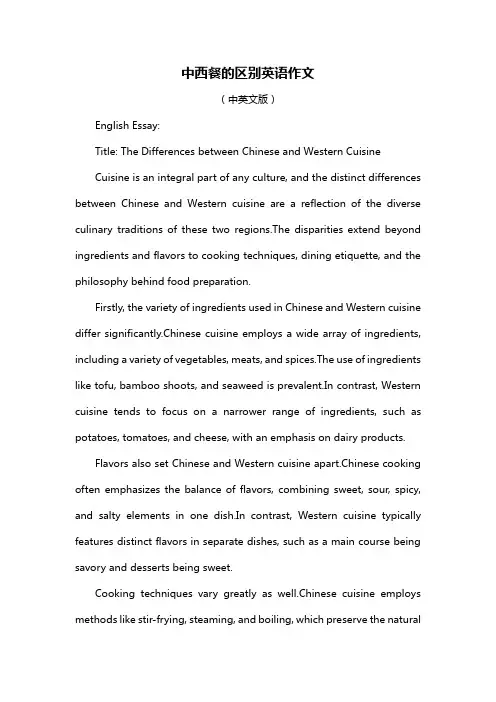
中西餐的区别英语作文(中英文版)English Essay:Title: The Differences between Chinese and Western CuisineCuisine is an integral part of any culture, and the distinct differences between Chinese and Western cuisine are a reflection of the diverse culinary traditions of these two regions.The disparities extend beyond ingredients and flavors to cooking techniques, dining etiquette, and the philosophy behind food preparation.Firstly, the variety of ingredients used in Chinese and Western cuisine differ significantly.Chinese cuisine employs a wide array of ingredients, including a variety of vegetables, meats, and spices.The use of ingredients like tofu, bamboo shoots, and seaweed is prevalent.In contrast, Western cuisine tends to focus on a narrower range of ingredients, such as potatoes, tomatoes, and cheese, with an emphasis on dairy products.Flavors also set Chinese and Western cuisine apart.Chinese cooking often emphasizes the balance of flavors, combining sweet, sour, spicy, and salty elements in one dish.In contrast, Western cuisine typically features distinct flavors in separate dishes, such as a main course being savory and desserts being sweet.Cooking techniques vary greatly as well.Chinese cuisine employs methods like stir-frying, steaming, and boiling, which preserve the naturalflavors and textures of the ingredients.On the other hand, Western cuisine frequently uses techniques like roasting, baking, and grilling, which often result in a more substantial and robust taste.Dining etiquette reflects cultural differences too.Chinese meals are communal affairs, with dishes being shared and placed at the center of the table.Chopsticks are the primary eating utensil, promoting interaction and a sense of community.In contrast, Western meals are more individualistic, with each person having their own portion and eating with a fork, knife, and sometimes a spoon.Lastly, the philosophy behind food preparation differs between the two cuisines.Chinese cuisine is deeply rooted in the principles of balance and harmony, with an emphasis on the health benefits of food.The concept of yin and yang is often applied, where certain ingredients are believed to have healing properties.Western cuisine, while also considering health aspects, tends to focus more on the presentation and creativity of dishes, often influenced by culinary trends and individual expression.In conclusion, the differences between Chinese and Western cuisine are multifaceted, encompassing ingredients, flavors, cooking techniques, dining etiquette, and the philosophy behind food preparation.These distinctions not only make each cuisine unique but also offer a fascinating window into the diverse culinary heritages of the world.中文作文:标题:中西方饮食的差异饮食是任何文化中不可或缺的一部分,中西方饮食之间的显著差异反映了这两个地区多样的烹饪传统。

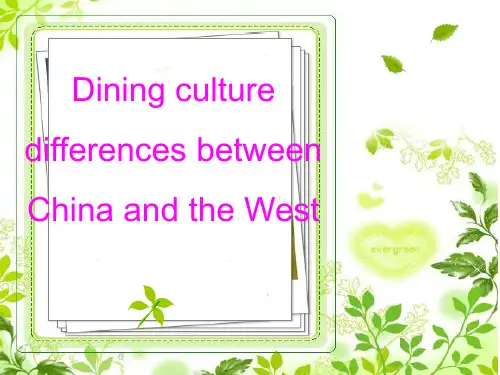
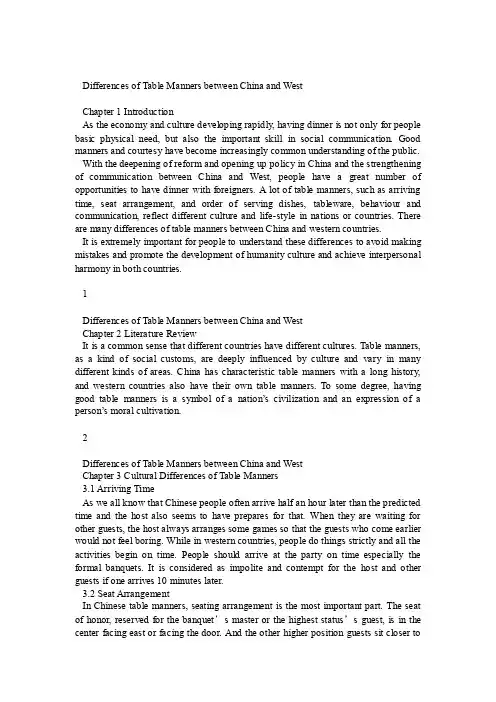
Differences of Table Manners between China and WestChapter 1 IntroductionAs the economy and culture developing rapidly, having dinner is not only for people basic physical need, but also the important skill in social communication. Good manners and courtesy have become increasingly common understanding of the public. With the deepening of reform and opening up policy in China and the strengthening of communication between China and West, people have a great number of opportunities to have dinner with foreigners. A lot of table manners, such as arriving time, seat arrangement, and order of serving dishes, tableware, behaviour and communication, reflect different culture and life-style in nations or countries. There are many differences of table manners between China and western countries.It is extremely important for people to understand these differences to avoid making mistakes and promote the development of humanity culture and achieve interpersonal harmony in both countries.1Differences of Table Manners between China and WestChapter 2 Literature ReviewIt is a common sense that different countries have different cultures. Table manners, as a kind of social customs, are deeply influenced by culture and vary in many different kinds of areas. China has characteristic table manners with a long history, and western countries also have their own table manners. To some degree, having good table manners is a symbol of a nation’s civilization and an expression of a person’s moral cultivation.2Differences of Table Manners between China and WestChapter 3 Cultural Differences of Table Manners3.1 Arriving TimeAs we all know that Chinese people often arrive half an hour later than the predicted time and the host also seems to have prepares for that. When they are waiting for other guests, the host always arranges some games so that the guests who come earlier would not feel boring. While in western countries, people do things strictly and all the activities begin on time. People should arrive at the party on time especially the formal banquets. It is considered as impolite and contempt for the host and other guests if one arrives 10 minutes later.3.2 Seat ArrangementIn Chinese table manners, seating arrangement is the most important part. The seat of honor, reserved for the banquet’s master or the highest status’s guest, is in the center facing east or facing the door. And the other higher position guests sit closer tothe master of the banquet. The lowest position guests sit furthest from the seat of honor. If it is a round table, the one facing the door is the guest of honor. The seats on the left hand are second, and then in turn fourth and sixth and so on. The guests on the right hand are the same.While in western countries, it is different. When the hostess announced dinner is ready, male host will lead guests to the table in turn, and the hostess walks behind them. Some host will also place name card on the table to show the seat.3.3 Order of Serving DishesChinese meals usually begin with appetizers. There are often four or five kinds of appetizers, such as, cold meats, preserved eggs, smoked fish and vegetable relishes. All these food are arranged beautifully on separate dishes or on one large platter. Then the hot food should be served. There is an important rule to serve the whole duck, chicken and fish, which is don’t put the head and tail to the major seat. After the hot dishes, then comes the main course, rice. At last, desserts and fruits are provided to help digestion.In western countries, the first dish is appetizer as well. The second dish is soup. The third dish is fish dish. Meat and poultry dishes is the fourth dish, which also known as the main course. And the most representative is beef and steak. Salad can be a kind of side dish, which can be arranged either after or with the meat dish. The sixth dish is dessert, such as pudding, ice cream, cheese, fruit and so on. The final drink is coffee with cream or tea with sugar.3Differences of Table Manners between China and West3.4 TablewareChinese people mainly use bowl, chopsticks and spoons. Chopsticks are the most important tableware in China. While in serving English meals, they use so much tablewares with different kinds and sizes. There are different kinds of glasses, spoons, plates, bowls and knives. The main tablewares in western are knives, forks, spoons, glass and napkin.3.5 Behaviour and CommunicationWhen on the dinner table, Chinese people talked a lot and enjoy the delicious food at the same time, which means the hospitality and sincere of hostess. Because they believe that the lively atmosphere on the dinner table reflects the cheerful of guests and the warmth of family. While in western, during the dinner, people talked little and cut their own food in the plate quietly.4Differences of Table Manners between China and WestChapter 4 Main Factors Causing the Differences4.1 GeographyThe geographical location and the environment lead to the differences between Chinese and western cultures. People in different places will have differentbehaviours and cultures.4.2 TraditionWith thousands of years of Chinese traditional culture, we believe that we should take care of others and cooperate with others. Chinese people use cheap chopsticks as tableware which can reflect Chinese collective consciousness. In the book Culture on Dinner Table, Mr. Yi Zhongtian said that the core thought of Chinese culture is group consciousness while the western core thought is individual consciousness. The western culture, to be self-centered, the boundary between people is very clear and they usually do not allow mutual interference. That makes western table manners without sharing a plate of food. Knife and fork also can reflect individual consciousness, and noble west of life.4.3 CustomPeople from different countries have different cultures and customs, especially in the aspects such as greeting, thanks, apology, flattery, and making telephone calls. When Chinese invited guests to have dinner, the host always picks food for guests and tries his best to make guests eat and drink more. While in western countries, the host would just let their guests help themselves and they would never carry food to their guest’s bowl.5Differences of Table Manners between China and WestChapter 5 Trend of SyncretismNowadays, an increasing number of western restaurants appear in many cities in China and an increasing number of people like to have meals in it. People have gradually learned western table manners in their daily life. It is obvious that the Chinese diet conception is sensible, and the western diet idea is rational. Now, the difference seems to become blurred with the strengthening of communication between China and West and the development of science. Instead of paying attention to the color, flavor and taste of the food, Chinese people, like the westerners, pay more attention to its health and nutrition. This dissemination and development of western style food has unavoidably made great influence on Chinese food and beverage industry, which made Chinese style food trade change in the aspects of managing concept, management mode, productive means, personnel cultivation and so on.6Differences of Table Manners between China and WestChapter 6 ConclusionSocial background, historical and cultural differences lead to the differences between Chinese and Western table manners. To some extent, table manner is a reflection of the kind of lifestyle, and the formation of habits which can not be obtained in a short period of time. It is actually a kind of historical and cultural sedimentation and extension. Knowing the differences, people can easily understandthe culture of each other. In face of these differences, we should comprehend and respect their habits and culture and remember that every culture is equal to the other. Only recognizing cultural differences between China and West and making a reasonable and effective integration, can we establish a social cultural etiquette system of contemporary China and reach the ideal harmonious society.7Differences of Table Manners between China and WestReferences[1] 易中天. 餐桌上的文化[J]. 当代学生, 2004(10).[2] 杨柳,田丹丹,苑富山. 中美餐桌礼仪刍议[J]. 从餐桌礼仪看中西文化差异[J]. 硅谷, 2008(18).8。
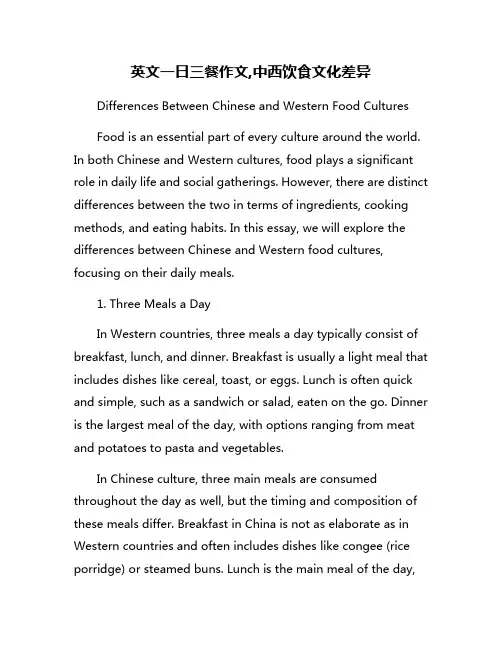
英文一日三餐作文,中西饮食文化差异Differences Between Chinese and Western Food CulturesFood is an essential part of every culture around the world. In both Chinese and Western cultures, food plays a significant role in daily life and social gatherings. However, there are distinct differences between the two in terms of ingredients, cooking methods, and eating habits. In this essay, we will explore the differences between Chinese and Western food cultures, focusing on their daily meals.1. Three Meals a DayIn Western countries, three meals a day typically consist of breakfast, lunch, and dinner. Breakfast is usually a light meal that includes dishes like cereal, toast, or eggs. Lunch is often quick and simple, such as a sandwich or salad, eaten on the go. Dinner is the largest meal of the day, with options ranging from meat and potatoes to pasta and vegetables.In Chinese culture, three main meals are consumed throughout the day as well, but the timing and composition of these meals differ. Breakfast in China is not as elaborate as in Western countries and often includes dishes like congee (rice porridge) or steamed buns. Lunch is the main meal of the day,with multiple dishes served family-style. Dinner tends to be lighter, with a focus on soups and stir-fried dishes.2. IngredientsOne of the most prominent differences between Chinese and Western cuisine is the ingredients used in cooking. In Western cooking, ingredients like meat, dairy, and grains are commonly used, resulting in hearty and rich dishes. On the other hand, Chinese cuisine utilizes a variety of fresh vegetables, seafood, and tofu, creating dishes that are lighter and more nutritious.Western cuisine often includes dairy products like cheese and butter, which are rarely found in Chinese cooking. Chinese cuisine, on the other hand, makes extensive use of soy sauce, vinegar, and spices like ginger and garlic to season dishes. The use of different ingredients in Chinese and Western cuisine contributes to the distinct flavors and textures of their respective dishes.3. Cooking MethodsThe cooking methods used in Chinese and Western cuisine also differ significantly. Western cooking methods tend to include grilling, roasting, and baking, resulting in dishes that arecrispy and flavorful. In contrast, Chinese cuisine often involves stir-frying, steaming, and braising, creating dishes that are tender and juicy.In Western countries, there is a strong emphasis on presentation and plating, with dishes arranged meticulously on the plate. Chinese cuisine, on the other hand, focuses more on the balance of flavors and textures, with an emphasis on harmony and contrast in dishes.4. Eating HabitsAnother key difference between Chinese and Western food cultures is eating habits. In Western countries, it is common to eat quickly and on the go, with meals often consumed in front of the television or computer. In Chinese culture, meals are typically enjoyed with family and friends, with an emphasis on sharing and communal dining.In Chinese culture, it is customary to serve a variety of dishes during a meal, allowing diners to sample different flavors and textures. In Western countries, individual portion sizes are more common, with each person having their own plate of food.In conclusion, Chinese and Western food cultures have distinct differences in terms of ingredients, cooking methods,and eating habits. Despite these differences, both cultures share a deep appreciation for food and the role it plays in bringing people together. By understanding and appreciating these differences, we can gain a greater appreciation for the diverse culinary traditions that exist around the world.。
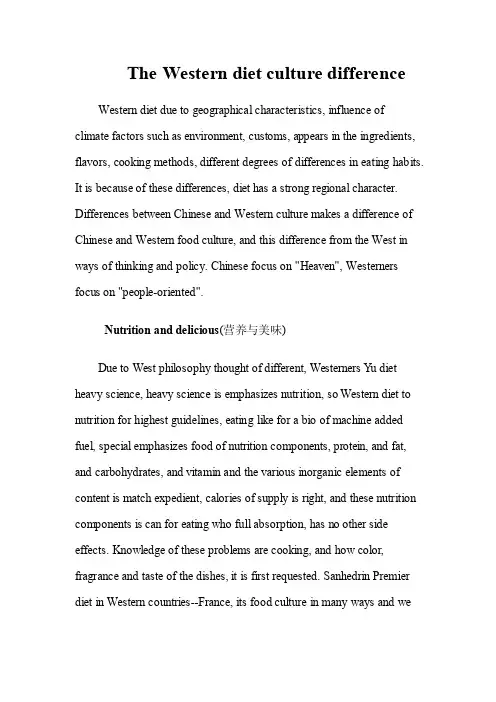
The Western diet culture difference Western diet due to geographical characteristics, influence of climate factors such as environment, customs, appears in the ingredients, flavors, cooking methods, different degrees of differences in eating habits. It is because of these differences, diet has a strong regional character. Differences between Chinese and Western culture makes a difference of Chinese and Western food culture, and this difference from the West in ways of thinking and policy. Chinese focus on "Heaven", Westerners focus on "people-oriented".Nutrition and delicious(营养与美味)Due to West philosophy thought of different, Westerners Y u diet heavy science, heavy science is emphasizes nutrition, so Western diet to nutrition for highest guidelines, eating like for a bio of machine added fuel, special emphasizes food of nutrition components, protein, and fat, and carbohydrates, and vitamin and the various inorganic elements of content is match expedient, calories of supply is right, and these nutrition components is can for eating who full absorption, has no other side effects. Knowledge of these problems are cooking, and how color, fragrance and taste of the dishes, it is first requested. Sanhedrin Premier diet in Western countries--France, its food culture in many ways and weapproximate, but access to nutritional problems, will open the distance between the two sides.Five flavors mixed with the operation aimed at the pursuit of delicious cooking in China, during the processing of the hot frying and slow fire attack for a long time may cause destruction of the nutritional components of food. France is also the pursuit of delicious cooking, but at the same time not forgetting "nutrition" that premise, consistently delicious is that they do not care nutrition for the taking. Especially modern cooking trends occurred in the 1960 of the 20th century, with special emphasis on health, diet, to the pursuit of light oil, emphasized the use of fresh raw materials, stressed during the cooking process to maintain original nutrition and taste, so vegetables are eaten raw. So that the Western diet nutrition is universal。

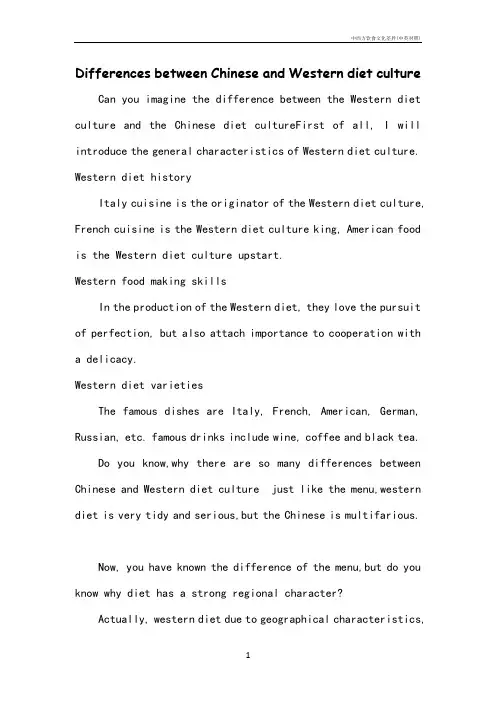
Differences between Chinese and Western diet culture Can you imagine the difference between the Western diet culture and the Chinese diet cultureFirst of all, I will introduce the general characteristics of Western diet culture. Western diet historyItaly cuisine is the originator of the Western diet culture, French cuisine is the Western diet culture king, American foodis the Western diet culture upstart.Western food making skillsIn the production of the Western diet, they love the pursuit of perfection, but also attach importance to cooperation with a delicacy.Western diet varietiesThe famous dishes are Italy, French, American, German, Russian, etc. famous drinks include wine, coffee and black tea.Do you know,why there are so many differences between Chinese and Western diet culture just like the menu,western diet is very tidy and serious,but the Chinese is multifarious.Now, you have known the difference of the menu,but do you know why diet has a strong regional character?Actually, western diet due to geographical characteristics,environment, customs, appears in cooking methods of differences in eating habits. People in western countries like to eat pizza, while Chinese people like to eat between Chinese and Western culture makes a difference of Chinese and Western food culture.事实上,西方饮食由于地域特色、环境、风俗习惯,出现烹调方法不同程度的差异。

小学英语作文中西饮食文化的不同全文共6篇示例,供读者参考篇1Food is Amazing! People in Different Places Eat Such Cool StuffI love food! Don't you? I could eat all day long if my mom would let me. I especially love trying new and different dishes from around the world. It's so much fun to explore diverse cuisines and flavors.My family is Chinese, so I've grown up eating lots of delicious Chinese food like dumplings, noodles, rice dishes, and stir-fries. But I've also had the chance to sample foods from many other cultures too. Some of my friends' families are from the West - places like the United States, Canada, the UK, and other European countries. The way they eat is quite different from how we eat in my Chinese household.One of the biggest differences is that in the West, people tend to eat meals that are more separate from each other. Like for dinner, they'll h ave an entrée as the main dish, maybe a meat or pasta or something. Then they'll have some side dishes like avegetable and a starch like potatoes or bread. We'll sometimes do that in my Chinese family too. But we also love shared dishes where we all take food from the same plates using our chopsticks and pile it onto our own plate or bowl of rice.Another big difference is how courses are eaten. In the West, you often have an appetizer first, like a salad or soup. Then the main course. And sometimes even a dessert course after that! In my Chinese family, we tend to just eat everything all together as part of the same meal. The dishes keep coming out one after another and you just nibble on them all at the same time.I find it really interesting how in the West, forks, knives, and spoons are the main utensils used. But in China, we primarily use chopsticks to eat almost everything! I had a hard time learning to use chopsticks when I was little篇2Title: A Tasty Exploration: Differences Between Chinese and Western Food CulturesHi there! My name is Lily, and I'm a fourth-grader who loves to learn about different cultures, especially when it comes to food. Today, I want to share with you some exciting differencesI've noticed between Chinese and Western food cultures. Get ready for a delicious adventure!Let's start with the most obvious difference: the types of food we eat. In China, rice is a staple food that's served at almost every meal. We have so many delicious rice dishes, like fried rice, congee (rice porridge), and even rice noodles! On the other hand, in Western countries like the United States or the United Kingdom, bread and pasta made from wheat are more common.Speaking of ingredients, Chinese cuisine uses lots of amazing sauces and seasonings like soy sauce, oyster sauce, and different types of vinegar. These sauces add so much flavor to our dishes! Western cuisines tend to rely more on herbs and spices like rosemary, thyme, and black pepper for seasoning.One thing I love about Chinese food is the emphasis on fresh vegetables and seasonal ingredients. My mom always takes me to the local market to pick out the freshest produce for our meals. In contrast, I've noticed that Western cuisines sometimes rely more heavily on processed or pre-packaged foods.Another fascinating difference is the way meals are served and eaten. In Chinese culture, it's common to have multiple dishes served at the same time, and everyone shares from the communal plates using chopsticks. This encourages a sense oftogetherness and family bonding during mealtimes. On the other hand, Western meals often consist of one main dish and a few side dishes, with each person having their own plate.The way we cook our food is also quite different. Chinese cooking often involves techniques like stir-frying, steaming, and braising, which help to preserve the natural flavors and nutrients of the ingredients. Western cuisines, on the other hand, frequently use methods like baking, roasting, and grilling.Another thing I find interesting is the way we approach snacks and desserts. In Chinese culture, we have a wide variety of delicious street foods and snacks like dumplings, steamed buns, and egg tarts. These are perfect for grabbing a quick bite on the go or sharing with friends. Western snacks, like chips, cookies, and candy bars, are often pre-packaged and can be found in vending machines or convenience stores.When it comes to desserts, Chinese sweets tend to be less sweet and use natural ingredients like red bean paste, lotus seed paste, and fresh fruit. Western desserts, like cakes, pies, and ice cream, are often richer and sweeter, with lots of sugar and heavy cream.One of my favorite parts of exploring different food cultures is learning about the traditions and symbolism behind certaindishes. In Chinese culture, certain foods are believed to bring good luck or prosperity. For example, long noodles symbolize a long life, and dumplings shaped like ancient Chinese currency represent wealth. In Western cultures, certain dishes may be associated with specific holidays or celebrations, like turkey for Thanksgiving or ham for Easter.Overall, exploring the differences between Chinese and Western food cultures has been an incredibly enriching experience for me. I've learned to appreciate the diversity of flavors, ingredients, and cooking techniques that exist around the world. Food is not only nourishment for our bodies but also a window into different cultures and traditions.I encourage you all to keep an open mind and try new foods from different cultures whenever you get the chance. Who knows, you might just discover a new favorite dish! And remember, food is meant to be enjoyed, so savor every bite and embrace the flavors of the world.篇3Title: Exploring the Flavors: Differences Between Chinese and Western Food CulturesHello, my name is Amy, and I'm a 10-year-old student who loves to learn about different cultures. Today, I want to share with you some interesting differences I've noticed between Chinese and Western food cultures. Get ready for a delicious journey!Let's start with the basics: eating utensils. In Chinese cuisine, chopsticks are the most commonly used utensils. They require a special technique to handle them properly, and it's fun to learn! In Western countries, people typically use forks, knives, and spoons. Both chopsticks and Western utensils have their own unique styles and traditions.Another fascinating difference is the way meals are served. In Chinese families, it's common to have several shared dishes placed in the center of the table. Everyone takes a little bit from each dish using their chopsticks or a serving spoon. It's like a big feast where everyone gets to taste everything! On the other hand, in Western culture, each person usually gets their own plate with a main dish and side dishes.Speaking of dishes, the ingredients and flavors used in Chinese and Western cuisines can be quite different. Chinese food often incorporates a variety of spices and seasonings like ginger, garlic, soy sauce, and chili peppers. These ingredientscreate bold, savory, and sometimes spicy flavors. Western dishes, on the other hand, tend to have a more subtle flavor profile, with herbs like rosemary, thyme, and basil being commonly used.One thing I find really interesting is the role of rice in Chinese cuisine. Rice is a staple food and is served with almost every meal. In Western countries, however, bread and potatoes are more common staples. Can you imagine having rice for breakfast, lunch, and dinner every day?Another difference lies in the presentation of the food. Chinese dishes often aim for a visually appealing arrangement, with careful attention paid to the colors, shapes, and textures of the ingredients. Western cuisine also values presentation, but the focus is more on the overall look of the plate rather than the individual components.Now, let's talk about something really fun: snacks and street food! Chinese street food is incredibly diverse, with options like dumplings, skewered meats, and all sorts of delicious fried treats. In Western countries, street food tends to be more focused on items like hot dogs, pretzels, and ice cream. Both cultures have their own unique and tasty snack traditions.One thing is for sure: food is not just about nourishment; it's also a reflection of a culture's history, traditions, and values. Bylearning about different food cultures, we can appreciate the diversity of the world and gain a deeper understanding of the people behind the flavors.So, the next time you sit down for a meal, whether it's a hearty Chinese hotpot or a classic Western burger, take a moment to appreciate the rich cultural heritage behind each bite. Who knows, you might just discover a new favorite dish or learn something fascinating about another part of the world!篇4The Differences Between Western and Chinese Food CulturesFood is a really important part of culture. Different cultures have their own special foods, eating habits, and food traditions. As a kid who has lived in both China and the United States, I've noticed lots of differences between how people eat in the West compared to China. Let me tell you about some of the biggest ones!One of the first things I noticed was the difference in staple foods. In China, the staple foods are rice, noodles, and steamed buns. Pretty much every meal includes one of those starchy foods as the base. But in Western countries like the US, the staplefoods are things like bread, pasta, and potatoes instead. At first it felt really weird eating a sandwich or plate of pasta as the main part of the meal rather than having it as a side dish.Speaking of side dishes, meals in the West often have just one main dish like a piece of meat or fish with everything else as side dishes on the same plate. But in China, every meal has a bunch of different small dishes that are meant to be shared among everyone at the table. You use your own bowl to get portions from the shared dishes. It's called family style dining. I like that because you get to try many different flavors!The way dishes are prepared and cooked is also quite different. A lot of Western cooking uses an oven to bake or roast foods. But in China, most dishes are stir-fried in a wok over high heat or steamed. Stir-篇5The Delightful Differences between Chinese and Western FoodsHi there! My name is Lily, and I'm a fourth-grader at Sunshine Elementary School. Today, I want to share with you some fascinating differences I've noticed between Chinese andWestern foods. As someone who loves trying new and tasty dishes, I find this topic truly exciting!Let's start with the most crucial aspect of any cuisine – the ingredients! In Chinese cooking, we often use a wide variety of fresh and flavorful ingredients like ginger, garlic, scallions, soy sauce, and various spices. These ingredients give our dishes a distinct aroma and taste that's hard to replicate elsewhere. On the other hand, Western cuisine tends to rely more on ingredients like butter, cream, cheese, and herbs like rosemary and thyme. While these ingredients are delicious in their own right, they create a completely different flavor profile from Chinese dishes.Another significant difference lies in the cooking methods used. Chinese cuisine heavily relies on techniques like stir-frying, steaming, and braising, which help preserve the natural flavors and textures of the ingredients. Stir-frying, in particular, is a popular method that involves quickly cooking ingredients over high heat, resulting in crunchy and flavorful dishes. In contrast, Western cuisine often incorporates baking, roasting, andsautéing, which can give foods a richer, more robust flavor.Now, let's talk about the dining experience itself. In Chinese culture, sharing dishes is a common practice. We often orderseveral dishes and place them in the center of the table, allowing everyone to sample various flavors. This promotes a sense of community and togetherness during mealtimes. Western dining, on the other hand, typically revolves around individual plates, where each person has their own main course and side dishes.One aspect I find particularly fascinating is the presentation of food. Chinese cuisine places a strong emphasis on the aesthetics of dishes, often arranging ingredients in visually appealing and artistic ways. Dishes are carefully plated, with attention paid to color, texture, and symmetry. Western cuisine, while still visually appealing, tends to be more focused on the overall taste and flavor of the dish, rather than its appearance.Speaking of flavors, Chinese cuisine is known for its balance of contrasting tastes – sweet, sour, salty, and spicy. Many dishes incorporate a combination of these flavors, creating a harmonious and complex taste profile. Western cuisine, on the other hand, often focuses on highlighting one or two main flavors, such as the richness of a creamy sauce or the tanginess of a vinaigrette.Lastly, let's talk about desserts! Chinese desserts are often lighter and less sweet than their Western counterparts. They frequently incorporate ingredients like red bean paste, lotusseeds, and fresh fruits. On the other hand, Western desserts tend to be richer and more indulgent, featuring ingredients like chocolate, buttercream, and caramel.As you can see, there are so many fascinating differences between Chinese and Western food cultures. From the ingredients used to the cooking methods employed, and from the dining experience to the presentation and flavors, these two culinary traditions offer a diverse and delightful range of tastes and experiences.While I'm proud of my Chinese heritage and the delicious dishes it has given the world, I also can't help but appreciate the unique flavors and culinary traditions of Western cuisine. In my opinion, the best way to enjoy both is to keep an open mind and a curious palate – because trying new foods is one of life's greatest adventures!篇6Eating Food from Different CulturesI love food! Don't you? Food is so tasty and fun. But did you know that people from different cultures around the world eat very different foods? China and Western countries like Americahave some big differences when it comes to their food cultures. Let me tell you about some of the cool things I've learned.In the West, they eat a lot of bread, cheese, and meat. One of their most popular foods is a sandwich. A sandwich has bread on the top and bottom with fillings like meat, cheese, vegetables or other yummy stuff in the middle. My friend Jack loves peanut butter and jelly sandwiches. In China, we don't really eat sandwiches that much. We prefer things like steamed buns, rice, and noodles.Western people also drink a lot of milk and eat a lot of dairy products like cheese, yogurt, and ice cream. In China, we don't drink as much milk after we're little kids. We get those nutrients from other foods instead. My grandma thinks milk makes you too phlegmy! I still like ice cream though - who doesn't?Speaking of dairy, cheese is a really big part of Western food culture. There are so many different kinds of cheeses made from cow, goat or sheep milk. Some are hard, some are soft, some are smelly, and some are mild. Cheese is used in all kinds of Western dishes and snacks. But in China, we don't eat that much cheese at all. My dad says it smells like stinky socks!The way Western and Chinese cuisines are prepared is quite different too. In the West, they use their ovens to bake and roasta lot of their food. Things like chicken, beef, potatoes, bread, cookies and pies are all cooked in the oven. But we don't have ovens in our homes in China. We use a wok over high heat to fry and stir-fry our dishes on the stovetop.Eating with forks, spoons and knives is very common in Western countries. But in China, we traditionally use chopsticks to eat our food. Using chopsticks is a skill you have to learn and practice. My little sister is still working on her chopstick skills and makes a big mess sometimes! In the West, they put a big emphasis on having a knife and fork to cut up their food into neat little bites.The flavors are different too. A lot of Western food tastes richer, with more cream, cheese, and oil. Chinese cooking uses lighter seasonings like soy sauce, rice vinegar, ginger and garlic. My teacher says Western food can taste heavier because they like to use more butter, salt and sauces. Personally, I like the lighter flavors of Chinese food better. But I have to admit, a nice creamy pasta or slice of pizza is hard to resist sometimes!You'll also find some very different drinks in China compared to the West. We drink a lot of hot tea, warm soy milk, and fruit juices. Westerners seem to prefer cold drinks like milk, soda pop, juice and fancy coffee drinks. My dad has an espresso machine athome and makes lattes and cappuccinos on the weekends. Those drinks have so much foam and milk in them! I prefer a nice cup of fragrant jasmine tea myself.The way meals are structured and eaten is quite different too. In the West, they tend to eat just one big plate with their main meal components like their meat, vegetable, and starch all together. We eat "family style" in China, where there are lots of shared dishes in the middle of the table. We take a little bit from each dish using our chopsticks or spoon.Desserts are another area of difference. Chinese desserts use a lot of fruits, beans, rice and sesame as ingredients. Things like sweet soups, puddings, and little gelatin squares. Western desserts seem to use more chocolate, cream, butter, flour and sugar to make things like cakes, pies, cookies, doughnuts and ice cream. Don't get me wrong, I love a good chocolate cake! But I also really enjoy our lighter, fruitier Chinese desserts.Food is such an important part of any culture. Despite all these differences, I think all foods from around the world are interesting and tasty in their own way. Food brings people together through shared meals and celebrations. I feel lucky that I get to experience both the cuisines of China and the West. It makes me appreciate how diverse the world's foods and culturesare. I can't wait to learn about and taste even more global foods as I get older!。
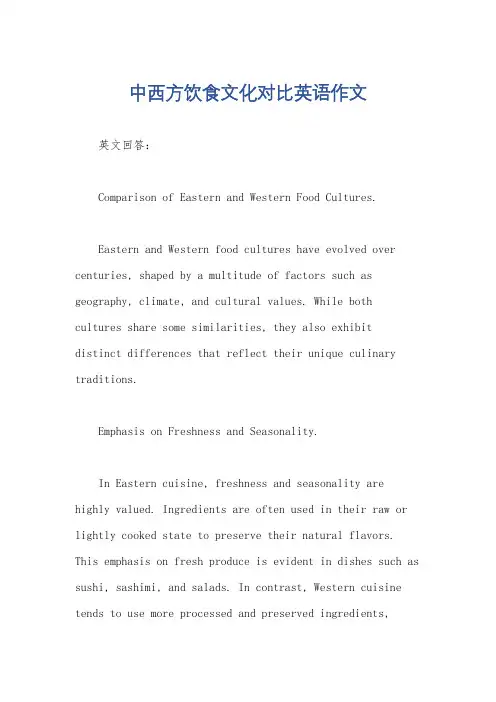
中西方饮食文化对比英语作文英文回答:Comparison of Eastern and Western Food Cultures.Eastern and Western food cultures have evolved over centuries, shaped by a multitude of factors such as geography, climate, and cultural values. While bothcultures share some similarities, they also exhibitdistinct differences that reflect their unique culinary traditions.Emphasis on Freshness and Seasonality.In Eastern cuisine, freshness and seasonality are highly valued. Ingredients are often used in their raw or lightly cooked state to preserve their natural flavors. This emphasis on fresh produce is evident in dishes such as sushi, sashimi, and salads. In contrast, Western cuisine tends to use more processed and preserved ingredients,allowing for greater flexibility in preparation and storage.Balance and Harmony.Eastern cuisine is characterized by a focus on balance and harmony. Dishes often combine a variety of flavors and textures, such as sweet, sour, salty, and bitter. This balance is achieved through the careful selection and combination of ingredients, as well as the use of cooking techniques that preserve the natural flavors of each ingredient. Western cuisine, on the other hand, often emphasizes a single dominant flavor, such as saltiness or sweetness, and may use more intense seasonings and sauces.Communal Dining.In Eastern cultures, dining is often a communal experience, with meals shared among family and friends. Dishes are typically served in large portions and placed in the center of the table, allowing everyone to partake. This communal aspect fosters a sense of togetherness and sharing. Western cuisine, while not always communal, often involvessmaller portion sizes and individual plates, reflecting a more individualized approach to dining.Influence of Religion.Religion has played a significant role in shaping both Eastern and Western food cultures. In the East, Buddhismand Taoism have influenced the development of vegetarianand vegan diets. Hinduism has also introduced a wide rangeof spices and herbs to Indian cuisine. In the West, Christianity has influenced fasting practices and dietary restrictions during Lent and other religious holidays.Availability of Ingredients.The availability of ingredients has also shaped the development of Eastern and Western food cultures. Eastern cuisine has long been influenced by the abundance of rice, vegetables, and seafood in Asia. Western cuisine, on the other hand, has historically relied on wheat, meat, anddairy products, which were more readily available in Europe.Impact of Globalization.Globalization has led to increased interaction and exchange between Eastern and Western food cultures. Ingredients, dishes, and culinary techniques from both cultures have become more widely available and incorporated into new and innovative cuisines. This has contributed to a greater appreciation and understanding of both Eastern and Western culinary traditions.中文回答:东西方饮食文化对比。
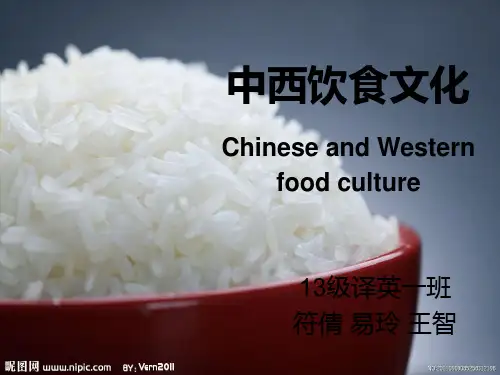
毕业论文题目浅析中西饮食文化的差异英文题目Differences Between Chinese and Western Food Culture院系专业姓名年级指导教师二零零七年六月AbstractFood plays an irreplaceable role in the development of society and the progress of human civilization. It is an essential prerequisite for human existence. However, different nations have different food and food habits. That is because they have different culture, especially food culture. Only within the context of each individual culture can food and food habits be best understood. This thesis expounds the important function of food culture between different countries’ cultural communication by analyzing Chinese and Western food culture. By examining these differences, we can improve our ability in cultural communication.Food culture is a special cultural phenomenon. B y the process of people’s studies, people know food culture from one side to the study of different culture backgrounds, customs and historical environments. This thesis endeavors to analyze the cultural differences and their root causes in Chinese and Western food cultures from the perspective of concept, etiquette and content, and points out that with the development of cross-cultural communication, more communication and interaction will arise between Chinese and western food cultures and they will develop together.Key words: value conception; feature; etiquette; Chinese food culture; western food culture摘要饮食作为人类生存的必要前提在人类社会的发展和文明进步中起着无可替代的作用。
中西方饮食习惯差异英语作文【篇一:中西方饮食文化差异英文版】the western diet culture differencewestern diet due to geographical characteristics, influence of climate factors such as environment, customs, appears in the ingredients, flavors, cooking methods, different degrees of differences in eating habits. it is because of these differences, diet has a strong regional character. differences between chinese and western culture makes a difference of chinese and western food culture, and this difference from the west in ways of thinking and policy. chinese focus on heaven, westerners focus on people-oriented.nutrition and delicious(营养与美味)due to west philosophy thought of different, westerners yu diet heavy science, heavy science is emphasizes nutrition, so western diet to nutrition for highest guidelines, eating like for a bio of machine added fuel, special emphasizes food of nutrition components, protein, and fat, and carbohydrates, and vitamin and the various inorganic elements of content is match expedient, calories of supply is right, and these nutrition components is can for eating who full absorption, has no other side effects. knowledge of these problems are cooking, and how color,fragrance and taste of the dishes, it is first requested. sanhedrin premier diet in western countries--france, its food culture in many ways and weapproximate, but access to nutritional problems, will open the distance between the two sides.five flavors mixed with the operation aimed at the pursuit ofdelicious cooking in china, during the processing of the hot frying and slow fire attack for a long time may cause destruction of the nutritional components of food. france is also the pursuit of delicious cooking, but at the same time not forgetting nutrition that premise, consistently delicious is that they do not care nutrition for the taking. especially modern cooking trends occurred in the 1960 of the 20th century, with special emphasis on health, diet, to the pursuit of light oil,emphasized the use of fresh raw materials, stressed during the cooking process tomaintain original nutrition and taste, so vegetables are eaten raw. so that the western diet nutrition is universal。
中外饮食文化差异英文作文Culinary cultures around the world have evolved over centuries, reflecting the unique histories, geographic locations, and societal values of different regions. When it comes to the distinct differences between Chinese and Western cuisines, several key factors stand out. From the fundamental ingredients and cooking methods to the rituals and social norms surrounding mealtimes, the divergent culinary traditions of China and the West offer a fascinating study in cross-cultural comparison.At the most basic level, the primary staple foods in Chinese and Western diets vary considerably. In China, rice and noodles made from grains like wheat and millet form the foundation of most meals. These starchy carbohydrates are typically served as the centerpiece, accompanied by an assortment of vegetable, meat, and seafood dishes. In contrast, the Western diet places greater emphasis on bread, potatoes, and pasta as the main starch components, with meat often occupying the most prominent position on the plate.The differences extend to the types of proteins commonly used aswell. Chinese cuisine makes extensive use of pork, chicken, and an array of seafood, including fish, shrimp, and squid. Beef, though increasingly popular in modern times, has historically played a more secondary role. Western diets, on the other hand, have traditionally relied more heavily on beef, lamb, and poultry, with seafood occupying a less central position.The contrasting dietary preferences are further reflected in the cooking methods employed. Chinese chefs place great importance on the wok, utilizing its high-heat capabilities to quickly sear, steam, and braise a variety of ingredients. Stir-frying, in particular, has become a signature technique that allows for the preservation of fresh flavors and crisp textures. Western cooking, in comparison, tends to favor slower, more deliberate methods like roasting, baking, and grilling, which often result in heartier, more substantial dishes.The seasoning and flavoring of foods also differ markedly between the two culinary traditions. Chinese dishes typically incorporate a complex blend of sauces, spices, and aromatics, such as soy sauce, rice vinegar, ginger, and garlic, to create bold, umami-rich tastes. Western cuisine, on the other hand, often relies on a more limited set of seasonings, such as salt, pepper, herbs, and occasionally butter or cream, to enhance the inherent flavors of the ingredients.Beyond the tangible aspects of ingredients and cooking methods,the social and cultural rituals surrounding mealtimes in China and the West also exhibit distinctive characteristics. In China, shared dishes placed at the center of the table encourage a communal dining experience, where family members and guests engage in lively conversation and the passing of food to one another. This communal style contrasts with the more individualized plate-service common in Western dining, where each person is typically served a single, self-contained portion.The pace and timing of meals also differ significantly. Chinese meals are often seen as an opportunity to savor and enjoy the process of eating, with courses served in a leisurely succession. Mealtimes in the West, in contrast, tend to be more hurried, with the emphasis placed on efficiency and productivity, rather than the pure enjoyment of the culinary experience.These divergent approaches to food and dining are deeply rooted in the cultural histories and societal values of China and the West. In China, the concept of food as a means of nourishing the body, mind, and soul has long been central to traditional philosophies like Daoism and Confucianism. The emphasis on balance, harmony, and the interconnectedness of all things is reflected in the holistic approach to Chinese cuisine.Western culinary traditions, on the other hand, have been moreheavily influenced by the rise of industrialization, urbanization, and the individualistic values of modern society. The focus on efficiency, convenience, and the pursuit of personal gratification has shaped the way Westerners approach food and mealtimes, often prioritizing speed and portion control over the communal, experiential aspects of dining.Despite these longstanding differences, however, the culinary landscapes of China and the West have begun to converge in recent decades, as globalization and cross-cultural exchange have facilitated the sharing of culinary ideas and techniques. Chinese restaurants have become ubiquitous in Western cities, introducing new flavors and dining customs to local populations. Conversely, Western-style fast food and casual dining establishments have gained a significant foothold in urban centers across China, catering to the evolving preferences of a rapidly modernizing society.This cross-pollination of culinary cultures has given rise to a fascinating fusion cuisine, where traditional recipes and cooking methods are adapted and reinvented to appeal to diverse palates. From Americanized Chinese dishes like chop suey and General Tso's chicken to the growing popularity of wood-fired Neapolitan pizza in China, the blending of culinary traditions has resulted in a rich tapestry of gastronomic experiences that defy simple categorization.As the world becomes increasingly interconnected, the exchange of culinary knowledge and the appreciation of diverse food cultures will continue to shape the way we understand and experience the act of eating. While the fundamental differences between Chinese and Western cuisines may persist, the ongoing dialogue between these two distinct culinary traditions promises to yield exciting new culinary innovations and a deeper, more nuanced understanding of the role that food plays in shaping our cultural identities and social experiences.。
Differences between Chinese and Western diet culture Can you imagine the difference between the Western diet culture and the Chinese diet culture?First of all, I will introduce the general characteristics of Western diet culture. Western diet historyItaly cuisine is the originator of the Western diet culture, French cuisine is the Western diet culture king, American food is the Western diet culture upstart.Western food making skillsIn the production of the Western diet, they love the pursuit of perfection, but also attach importance to cooperation with a delicacy.Western diet varietiesThe famous dishes are Italy, French, American, German, Russian, etc. famous drinks include wine, coffee and black tea.Do you know,why there are so many differences between Chinese and Western diet culture ?just like the menu,western diet is very tidy and serious,but the Chinese is multifarious.Now, you have known the difference of the menu,but do you know why diet has a strong regional character?Actually, western diet due to geographical characteristics, environment, customs, appears in cooking methods ofdifferences in eating habits. People in western countries like to eat pizza, while Chinese people like to eat dumplings.Differences between Chinese and Western culture makes a difference of Chinese and Western food culture.事实上,西方饮食由于地域特色、环境、风俗习惯,出现烹调方法不同程度的差异。
餐饮产品由于地域特征、气侯环境、风俗习惯等因素的影响,会出现在原料、口味、烹调方法、饮食习惯上的不同程度的差异。
正是因为这些差异,餐饮产品具有了强烈的地域性。
中西文化之间的差异造就了中西饮食文化的差异,而这种差异来自中西方不同的思维方式和处世哲学。
中国人注重“天人合一”,西方人注重“以人为本”。
这里简要从下面三个方面谈谈中西方饮食文化的差异。
The dining product as a result of factor and so on region characteristic, climatic environment, manners and customs influences, will appear in raw material, the taste, the cooking method, the food habit varying degree difference. Was precisely because of these differences, the dining product had the intense localization. Between China and the West culture's difference has accomplished China and the West diet culture difference, but this kind of difference and gets along with people the philosophy from the West different thinking mode. The Chinese pays great attention “the beauty to uni te”, the westerner pays great attention “humanist”. here chats the Western diet culture difference briefly from the following three aspects. 第二种翻译:Food products due to geographical features, climate, customs, and other factors, will appear in the raw materials, food, cooking methods, dietary habits on the varying degrees of difference. It is precisely because of these differences in food products with a strong regional. The difference between Chinese and Western cultures to create a diet of Chinese and Western cultural differences, and differences from the West in a different way of thinking and philosophy of life. Chinese people pay attention to the "Heaven and Man," in the West focus on "people-oriented."From here, a brief talk about the following three areas in the Western diet and cultural differences.一、两种不同的饮食观念对比注重“味”的中国饮食,西方是一种理性饮食观念。